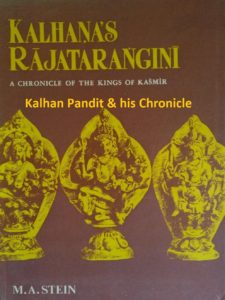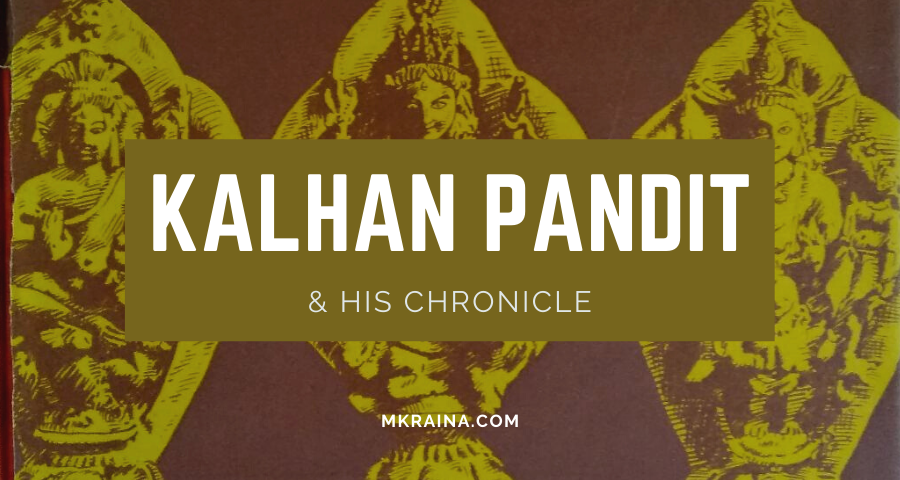Kalhan Pandit, the author of Rajatarangini was the son of Lord Champak, a minister of King Harsha (1089-1101 AD). Champak is refered to as Lord of the Gate or commandant of the frontier defences in the later part of Harsha’s reign. Kalhana mentions Champak amongst the last few officials who loyally held out by the King’s side.

Champak was a fervent worshipper at the Tirthas of Nandikshetra, the present Buthsher. Champak had a brother younger to him whose name was Kanak. Music loving King Harsha used to take lessons in singing from Kanak. King had prsented him one lac of gold coins for this. Kanaka is said to have saved the colossal Buddha image at Parihaspora, his birth place from destruction by King Harsha by his timely intercession.
It can not be doubted that Kalhan’s family was Brahman by caste. Sanskrit learning of the type displayed in the Rajatarangini has been always cultivated chiefly by Pandits of Brahman descent. He was attached to Shiva worship which had occupied the first place among the Hindu cults of the Valley. Tantric cult seems to have been well known to Kalhan. He has also displayed manifestly friendly attitude towards Buddhism throughout the whole of his Chronicle. Kalhan is also said to have inherited a culture, the Buddhist background of which was intimately connected with Gandhara. Gandhara in Afghanistan, as we know from the Rig Veda, was the meeting ground of the Indo-Aryans and the Iranians. King Meghavahana of Kashmir, the apostle of non-violence is said to have come from Gandhara.
Kalhan began his work in the Saka year 1070 corresponding to year 4224 of the Laukika era and 1148 AC. He finished it in the year 1150 AC. He relied upon the earlier chronicles which were extant in his day to ascertain the dates of the ancient Kashmiri rulers. He begins his account from 1184 BC with Gonanda III but he refers to an earlier period of 1266 years preceding 1184 BC, during which, according to tradition, 52 kings had ruled but of whom all record was lost.
Kalhan has not given any account of his education or early studies in his Chronicle. However, Sanskrit classical poetry of the Kavya type such as Kalhan knew and cultivated, presupposes a thorough training in the science of Indian rhetoric the Alamkarasastra and an equal mastery of the grammatical lore. He also had the very intimate knowledge of the Mahabharata. He seems to have been equally well acquainted with the Ramayana though his quotations from it are less numerous as compared to Mahabharata. It can safely be surmised that the study of the sacred epics had directly influenced Kalhan in the choice of his task.
Rajatarangini
The Rajatarangini or River of Kings is a poem in Sanskrit in eight cantos. Each canto is called Tarang or Wave. As said earlier, Poet Kalhan Pandit, the author of this saga of Kashmir commenced his composition in the year 1148 A.C. and concluded it in 1150 A.C.
Rajatarangini is the oldest and fullest record of Kashmir history. Sir Stein, recognising the inestimable value of the only work of its kind, succeeded in publishing the critical edition of the text as early as in 1892. Later he followed this illustrious venture by presenting a fully annotated translation of the Chronicle in 2 volumes. The mature, profound and thoroughgoing investigations of Sir Aurel Stein with his clear and invigorating language brought brilliance to the original text of Kalhan.
First translation of a portion of the Rajatarangini Bahr-ul-Asmar was in Persian made on the orders of the King Zain-ul-Abidin of Kashmir (1421-1472 A.C.) In 1594 A.C., the historian Abdul Kadir Al Badaoni was ordered by Emperor Akbar to complete the translation. In Ain-e-Akbari, Abul Fazal included an abstract of the early history of Kashmir of which he mentions Kalhan’s work as the source.
Dr. Bernier, who gave the first accurate and attractive European account of the Kashmir valley in 1664, had turned his attention to the histories of the ancient kings of Kashmir. The Chronicle of which he possessed a copy and was reportedly preparing a French translation, was however not Kalhan’s work but a Persian compilation of Haider Malik, Chadura prepared in Jehangir’s time avowedly with the help of Rajatarangini. Mr. Gladwin had also published his translation of the Ain-e-Akbari of Abu-l-Fazl who distinctly quoted Kalhan’s Chronicle as the authority for his own abstract of early Kashmir history, thus inviting attention to the original Sanskrit text.
In the year 1805, Mr. Colbrooke secured in Calcutta (now Kolkata) an incomplete copy of Kalhan’s work though his intention to give an account of its contents was realised only after twenty years. Dr. Horace Hayman Wilson first acquainted European students with the general character of Kalhan’s work and furnished critical abstract of the contents of its first six cantos. Even before Prof. Wilson’s Essay on the ‘Hindu History of Kashmir’ was published, Mr Moorecroft had made successful endeavour in Kashmir itself to obtain better textual material. He got Devanagari manuscripts prepared from an old Sharada manuscript in Srinagar in 1823, which was no other than the codex archetypus of all extant Kashmirian manuscripts. Nevertheless, the editio princeps of the Rajatarangini which appeared in 1835 under the auspices of the Asiatic Society, Bengal and which was mainly based on Mr. Moorcrofts transcript, failed to furnish a critically reliable text of the Chronicle. In 1840, Mr. A. Troyer, Principal of the Calcutta Sanskrit College began publication of a new edition of the text and of a French translation under the auspices of the Societe Asiatique at Paris. His translation accompanied by elaborate historical and geographical dissertations was completed in 1852.
General A. Cunningham was able to elucidate with remarkable success a series of important questions bearing on the chronological system of the Rajatarangini and on the numismatic history of the country. With the help of information obtained through local enquiries, he correctly ascertained the era employed in Kalhan’s chronological reckoning and thus succeeded in fixing with fair accuracy the dates for almost all the kings from the advent of the Karkota dynasty onwards.
No attempt was however made to secure the trustworthy materials before the contents of the Chronicle could be made fully available for historical and antiquarian study. It was Prof. G. Buhler, then of the Bombay Education Department, who during the summer of 1875 visited Kashmir in search of Sanskrit manuscripts. By the examination of good though modern Sharada copies of the Chronicle, Prof. Buhler was able to prove the absolute superiority of the Kashmir manuscripts over the Devanagari manuscripts. He was of the view that a new attempt to translate and to explain the Rajatarangini and to use its contents for the history of India was required to be made. He was sure it was a work of very considerable difficulty and would require much time and patience. Prof. Buhler had himself at one time planned to undertake the work which had attracted so much of his interest but other tasks prevented him from doing so after his return to Eurpe in 1881.
Dr. E. Hultzsch utilised the manuscript materials which Prof. Buhler had collected and others obtained during his own visit to Kashmir in 1885 for a series of articles. They were intended to supply an abstract translation and historical summary of the Chronicle.
Mr. Yogesh Chander Dutt’s English version of Rajatarangini ‘Kings of Kashmir : being a translation of the Sanskrit work Rajatarangini of Kalhana Pandita’ appeared at Calcutta in 1879-87. This translation, though published some time after Prof. Buhler’s researches, is said to be based exclusively on the corrupt text of the Calcutta edition of 1835.
Two Kashmiri Pandit scholars, Pandit Rajanaka Ratnakantha and Pandit Govind Kaul have had significant roles to play in the work undertaken by M.A.Stein. Recognising the value of their work, Stein writes, “My first endeavour was to secure the use of the codex archetypus of all extant manuscripts of the Chronicle, of which Prof. Buhler had not been allowed more than a glimpse. I was able to ascertain that the codex had been written by a well known Kashmirian scholar Pandit Rajanaka Ratnakantha probably about the third quarter of the seventeenth century and it contains besides a wealth of various readings and corrections from several old hands, a great number of important glosses.” He also writes, “It was fortunate that I was able to conduct many of the enquiries and in particular those connected with Pandit traditions and the customs and manners of the Brahman population with the help of my lamented friend Pandit Govind Kaul of Srinagar. ….. Pandit Govind Kaul held his store-house of old-world lore and learning ever open to me.”
Registering his grief over the demise of Pt. Govind Kaul, Stein writes, “By arranging under my directions, provisional Sanskrit indices for the Rajatarangini, the later chronicles and other Kashmirian texts requiring constant reference, and by similar labours he lightened for me the great burden of mechanical work which is inseparable from such a task. …… It is a source of true sorrow to me that this faithful assistant of my labours is no longer among the living. Pandit Govind Kaul died at Srinagar in the summer of 1899. I hope this public acknowledgement of his services will help to preserve the memory of a scholar who was worthy to maintain the learned traditions of the land of Sharada”.
Sir Aurel Stein published a critical edition of the Rajatarangini in 1892 at Bombay (now Mumbai). About the same time, Pandit Durga Prasad also brought out his edition published by Nirnay Sagar Press at Bombay.
Sir Aurel Stein finished his work of translation and the notes accompanying it in manuscript in 1896. He was however convinced that from the point of view of the critical student, it was necessary to examine systematically and in a connected form, many important questions relating to the personality of the author, the character and scope of his Chronicle and its value as a source of historical information. He was granted once more a two moth’s period of special duty by the Kashmir Durbar and the Punjab University induced by the Eleventh International Congress of Orientalists in 1897.
Sir Stein completed translation of the Chronicle into English prose in 1900. In his introduction to the translation, he says about Pandit Durga Prasad, “The Pandit’s edition contains also a considerable number of useful new emendations besides others which had already been proposed in my edition. Wherever I saw good reason to adopt such emendations for my translation, their source has been duly indicated in the notes. To the scholarly merits of his work, I may hence be allowed to render here a well-deserved tribute.”
Sources: Kalhana’s Rajatarangini by M.A.Stein;
Kalhana’s Rajatarangini by R.S.Pandit]

